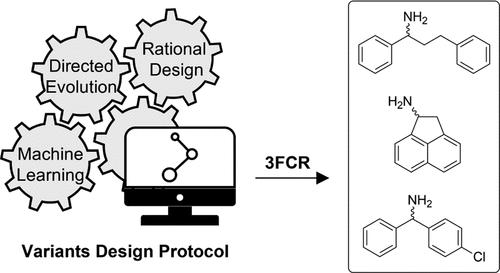当前位置:
X-MOL 学术
›
ACS Catal.
›
论文详情
Our official English website, www.x-mol.net, welcomes your feedback! (Note: you will need to create a separate account there.)
Practical Machine Learning-Assisted Design Protocol for Protein Engineering: Transaminase Engineering for the Conversion of Bulky Substrates
ACS Catalysis ( IF 12.9 ) Pub Date : 2024-04-12 , DOI: 10.1021/acscatal.4c00987 Marian J. Menke 1 , Yu-Fei Ao 1, 2, 3 , Uwe T. Bornscheuer 1
ACS Catalysis ( IF 12.9 ) Pub Date : 2024-04-12 , DOI: 10.1021/acscatal.4c00987 Marian J. Menke 1 , Yu-Fei Ao 1, 2, 3 , Uwe T. Bornscheuer 1
Affiliation

|
Protein engineering is essential for improving the catalytic performance of enzymes for applications in biocatalysis, in which machine learning provides an emerging approach for variant design. Transaminases are powerful biocatalysts for the stereoselective synthesis of chiral amines but one major challenge is their limited substrate scope. We present a general and practical variant design protocol for protein engineering to combine the advantages of three strategies, including directed evolution, rational design, and machine learning, and demonstrate the application of the protocol in the protein engineering of transaminases with higher activity toward bulky substrates. A high-quality data set was obtained by rational design of selected key positions, which was then applied to create a machine learning model for transaminase activity. This model was applied for the data-assisted design of optimized variants, which showed improved activity (up to 3-fold over parent) for three bulky substrates, maintaining enantioselectivity of the starting enzyme scaffold as well as improving the enantiomeric excess (up to >99%ee).
中文翻译:

蛋白质工程实用机器学习辅助设计方案:用于大体积底物转化的转氨酶工程
蛋白质工程对于提高生物催化应用中酶的催化性能至关重要,其中机器学习为变体设计提供了一种新兴方法。转氨酶是手性胺立体选择性合成的强大生物催化剂,但一个主要挑战是其有限的底物范围。我们提出了一种通用且实用的蛋白质工程变体设计方案,结合了定向进化、理性设计和机器学习三种策略的优点,并展示了该方案在对大体积底物具有更高活性的转氨酶的蛋白质工程中的应用。通过对选定关键位置的合理设计,获得了高质量的数据集,然后将其应用于创建转氨酶活性的机器学习模型。该模型应用于优化变体的数据辅助设计,该变体显示出三种大体积底物的活性得到改善(高达亲本的 3 倍),保持起始酶支架的对映选择性,并改善对映体过量(高达 > 99%ee)。
更新日期:2024-04-13
中文翻译:

蛋白质工程实用机器学习辅助设计方案:用于大体积底物转化的转氨酶工程
蛋白质工程对于提高生物催化应用中酶的催化性能至关重要,其中机器学习为变体设计提供了一种新兴方法。转氨酶是手性胺立体选择性合成的强大生物催化剂,但一个主要挑战是其有限的底物范围。我们提出了一种通用且实用的蛋白质工程变体设计方案,结合了定向进化、理性设计和机器学习三种策略的优点,并展示了该方案在对大体积底物具有更高活性的转氨酶的蛋白质工程中的应用。通过对选定关键位置的合理设计,获得了高质量的数据集,然后将其应用于创建转氨酶活性的机器学习模型。该模型应用于优化变体的数据辅助设计,该变体显示出三种大体积底物的活性得到改善(高达亲本的 3 倍),保持起始酶支架的对映选择性,并改善对映体过量(高达 > 99%ee)。



























 京公网安备 11010802027423号
京公网安备 11010802027423号